Research Article - (2021) Volume 11, Issue 2
Abstract
The article highlights the results of studying the influence of agrometeorological conditions on the growth and development of spring wheat, the variability of morphological markers of the studied samples. The regularities of the influence of hydrothermal factors of growing conditions on the duration of interphase periods of spring wheat have been clarified. We established that at the beginning of the vegetation, the onset of development phases is significantly influenced by the amount of precipitation. During the formation of generative organs, the most significant impact on plants is caused by the complex hydrothermal factor HTC (hydrothermal coefficient. The success of using samples of the genus Triticum L. as an adaptive potential of the genetic resources of soft wheat depends to some extent on their environmental factors, which to some extent modify and inherit the varieties created with their participation. All these issues are very relevant and insufficiently researched, and in the conditions of the eastern Forest-Steppe of Ukraine, they have not been studied at all. This question is especially true of amphidiploid specimens. The variability of morphological and economically valuable traits must be considered when developing new models of varieties. The characteristics of spring wheat samples of different ecological and geographical origin are presented Triticum aestivum, Triticum durum, Triticum мonococcum, Triticum boeoticum, Triticum sinskajae, Triticum timopheevii, Triticum militinae, Triticum dicoccum, Triticum ispahanicum, Triticum persicum, Triticum turgidum, Triticum aethiopicum, Triticum spelta, Triticum compactum, and amphidiploid specimens.
Keywords
spring wheat, variability, sample, collection, pubescence, mass, ear, development.
Introduction
Due to global climate change, adaptive and ecological selection, which is aimed at stabilizing crop yields, has become especially important in recent years. The modern model of a grade should provide a high level of productivity in combination with climatic conditions, both favorable and not to reduce it at unfavorable, to possess high homeostasis of the production process (Zubets, 2010). The selection of source material among the huge polymorphism of Triticum L. samples using an ecological approach and the cultivation of varieties with high potential productivity remains one of the main priorities for crop improvement.
The yield of spring wheat is determined by the number of plants per unit area and the productivity of an individual plant, which in turn includes productive business, the number of grains in the ear, and the weight of one ear. Several researchers point to the decisive role of productive business in forming high-yielding wheat agrocenoses and the close relationship between these traits. Theoretical substantiation and practical implementation of the program of adaptive and ecological selection of soft spring wheat based on morphometric traits as genetic markers of valuable traits, which will establish the degree of homogeneity of plants by morphometric traits in samples of different species. To determine the influence of genotype-environmental interactions on the manifestation of morphometric traits and productivity of soft spring wheat, soft spring can select the best samples of complex functional traits as source material for further selection.
A significant indicator in the formation of crop productivity is the ability of plants to fully undergo all phenological phases, which further affects both the yield of the crop and the quality of seeds. The onset of phenological phases and their duration largely depend on the year's weather conditions (Koshkin, 2010). Weather conditions cannot be controlled, but they can be adapted to achieve the maximum integrated result (Musienko, 2006). Agrometeorological conditions change from year to year, affecting the primary indicator of agricultural production - crop yields. The low stability of agricultural production significantly affects all integrated indicators of the country's economy, including national products. Therefore, one of the main tasks of optimizing agricultural production, including grain production, is developing ways to consider and reduce weather risk (Zubets, 2010).
The aim is to analyze the variability of morphological markers of the genus Triticum L. depending on the ecological and geographical origin to determine the morphological descriptors that can be used in the selection of source material. Also, to establish the influence of ecological and climatic conditions of the region on the duration of interphase periods of various samples and show possibilities of use of the received data at the selection on adaptability).
Materials and Methods
Field research was conducted in 2018–2019 at the Educational Research and Production Center "Experimental Field of V.V. Dokuchaiev Kharkiv National Agrarian University (KhNAU named after V.V. Dokuchaiev). The experimental field is located within the land use of the educational and experimental farm of V.V. Dokuchaiev Kharkiv National Agrarian University in the northeastern part of the Kharkiv region. Sowing was carried out in the optimal time for the culture of the first decade of April. Collectible samples were sown by hand under a marker, two rows 1 m long each with a row spacing of 0.15 m, at the rate of 100 grains per running meter. The estimated area of the plot for each sample was 1m2. All phenological observations were performed following the guidelines for the study of wheat collections.
The species were used as starting material of 76 samples Triticum aestivum, Triticum durum, Triticum monococcum, Triticum boeoticum, Triticum sinskajae, Triticum timopheevii, Triticum militinae, Triticum dicoccum, Triticum ispahanicum, Triticum persicum, Triticum turgidum, Triticum aethiopicum, Triticum spelta, Triticum compactum and amphidiploid specimens. The source material was obtained from the National Center for Plant Genetic Resources of Ukraine (NCGRRU) and had some economically valuable features. Samples were introduced from different ecological and geographical areas (Tables 1-3).
| n / a | National catalog number | Institution registration number | Sample name | Variety | Country of origin |
|---|---|---|---|---|---|
| Triticum aestivum | |||||
| 1 | UA 0100098 | IR 08517S | Sunnan | var. lutescens | SWE |
| 2 | UA 0101113 | IR 11742S | Prokhorovka | var. lutescens | RUS |
| 3 | UA 0104110 | IR 12602S | Kharkiv 30 | var. lutescens | UKR |
| 4 | UA 0106145 | IR 13173S | L 501 | var. lutescens | RUS |
| 5 | UA 0110938 | IR 15164S | Simkodamironovskaya | var. lutescens | UKR |
| 6 | UA 0111008 | IR 15206S | Yrym | var. erythrospermum | KAZ |
| 7 | UA 0105661 | IR 12049S | CIGM.250- | var. erythrospermum | MEX |
| 8 | UA 0110937 | IR 14892S | Phyto 14/08 | var. erythrospermum | UKR |
| 9 | UA 0110936 | IR 14891S | Phyto 33/08 | var. erythrospermum | UKR |
| 10 | UA 0111123 | IR 15595S | L 685-12 | var. lutescens | UKR |
| Triticum durum Desf | |||||
| 11 | UA0201229 | IR 12313S | Zolotko | var. muticohordeiforme | UKR |
| 12 | UA0201199 | IR 13580S | Orenburgskaya 21 | var hordeiforme | RUS |
| 13 | UA0201431 | IR 14943S | Nurly | var. hordeiforme | KAZ |
| 14 | UA0201201 | IR 14045S | Slavuta | var. leucomelan | UKR |
| 15 | UA0200923 | IR 12773S | Bukuría | var. melanopus | UKR |
| 16 | UA0201428 | IR 14941S | Altun Segus | var. hordeiforme | KAZ |
| 17 | UA0201386 | IR 14438S | Metiska | var. melanopus | UKR |
| 18 | UA0201452 | IR 15566S | Novacia | var hordeiforme | UKR |
| 19 | UA0201453 | IR 15548S | Diana | var. hordeiforme | UKR |
| 20 | UA0201426 | IR 14937S | Kustanayskaya 30 | var. hordeiforme | KAZ |
Table 1. Characteristics of the studying samples Triticum aestivum and Triticum durum
| n / a | National catalog number | Form | Variety | Country of origin |
|---|---|---|---|---|
| 1 | UA0300104 | monococcum | var. vulgare | BGR |
| 2 | UA 0300221 | monococcum | var. monococcum | AZE |
| 3 | UA 0300223 | monococcum | var. vulgare | ALB |
| 4 | UA 0300254 | monococcum | var. monococcum | ARM |
| 5 | UA 0300282 | monococcum | var. monococcum | HUN |
| 6 | UA 0300310 | monococcum | var. hohensteinii | GEO |
| 7 | UA 0300311 | monococcum | var. nigricultum | SYR |
| 8 | UA 0300313 | monococcum | – | HUN |
| 9 | UA0300402 | boeticum | var. boeticum | UKR |
| 10 | UA0300224 | sinskajae | var. sinskajae | RUS |
| 11 | UA0300545 | timopheevii | var. nigrum | BLR |
| 12 | UA0300257 | militinae | var. militinae | RUS |
| 13 | UA0300008 | dicoccum | var. aeruginosum | RUS |
| 14 | UA0300327 | dicoccum | var. aeruginosum | RUS |
| 15 | UA0300407 | dicoccum | var. nudidicoccum | UKR |
| 16 | UA0300406 | dicoccum | var. nudirufum | UKR |
| 17 | UA0300199 | dicoccum | var.pseudogunbadi | IRN |
| 18 | UA0300009 | dicoccum | var.serbicum | RUS |
| 19 | UA0300183 | dicoccum | var.serbicum | RUS |
| 20 | UA0300021 | dicoccum | var. volgense | KAZ |
| 21 | IU070615 | dicoccum | var.submajus | BGR |
| 22 | IU0700070 | ispahanicum | var. ispahanicum | IRN |
| 23 | UA0300490 | persicum | var. persicum | GEO |
| 24 | UA0300495 | persicum | var. rubiginosum | GEO |
| 25 | UA0300110 | turgidum | var. plinianum | KGZ |
| 26 | UA0300237 | turgidum | var.rubroathrum | GRC |
| 27 | UA0300376 | turgidum | – | BGR |
| 28 | IU070589 | aethiopicum | var.nigriviolaceum | ERI |
| 29 | UA0300238 | spelta | var.subbaktiaricum | UZB |
| 30 | UA0300304 | spelta | var.album | AUS |
| 31 | UA0300387 | spelta | var.caeruleum | CAN |
| 32 | UA0300388 | spelta | var.duhamelianum | CAN |
| 33 | UA0300391 | spelta | var.caeruleum | CAN |
| 34 | UA0300392 | spelta | var.alefeldii | CAN |
| 35 | UA0300398 | spelta | var.arduini | UKR |
| 36 | UA0300443 | spelta | var.caeruleum | RUS |
| 37 | UA0300546 | spelta | var.caeruleum | RUS |
| 38 | UA0300240 | compactum | var.erinaceum | ARM |
| 39 | UA0300354 | compactum | var.pseudoicterinum | GRC |
| 40 | UA0300368 | compactum | var.humboldtinflatum | CHN |
| 41 | UA0300528 | compactum | var.kerkianum | GEO |
Table 2. Characteristics of the studied samples of the genus Triticum L.
| n / a | National catalog number | Sample name | Pedigree | Country of origin | Institution of origin |
|---|---|---|---|---|---|
| 1 | UA0500004 | PAG - 12 | T. persicum x T.monococcum | RUS | VIR |
| 2 | UA0500007 | PAG - 20 | T. timococcum x T.monococcum | RUS | VIR |
| 3 | UA0500008 | PAG – 31 | T. dicoccum и-329428, Poland х T. | RUS | VIR, DOS VIR |
| monococcum k-20636, Ispaniya | |||||
| 4 | UA0500009 | PAG – 32 | T. dicoccum к-14055, Armenia x T. | RUS | VIR, DOS VIR |
| monococcum и-452639, Czech | |||||
| Republic | |||||
| 5 | UA0500010 | PEAG | T. dicoccum и-244569, Germany х | RUS | VIR, DOS VIR |
| Ae. Tauschii л-110 | |||||
| 6 | UA0500014 | Triticum x kiharae | T. timococcum x Ae. Tauschii | JPN | |
| 7 | UA0500018 | Haynatricum | АD (T.dicoccum-D.villosum) | RUS | Moscow Agricultural Academy. K.A. Timiryazeva, Russia |
| 8 | UA0500022 | АD8 | T. dicoccum x Ae. triuncialis | AZE | Research Institute of Genetics and Breeding of the Academy of Sciences of the Republic of Azerbaijan |
| 9 | UA0500023 | PAG - 13 | T. dicoccum x T. monococcum | RUS | VIR |
| 10 | UA0500024 | PAG - 39 | T. dicoccum x к-150007, Poland х T.sinskajae | RUS | VIR, DOS VIR |
| T. timopheevii x T. monococcum | |||||
| 11 | UA0500025 | Triticum x timococcum |
RUS | Moscow Agricultural Academy. K.A. Timiryazeva, Russia |
|
| 12 | UA0500026 | Triticum x sinskourarticum | T. sinskajae x T.urartu | ARM | Armenian СHI |
| 13 | UA0500043 | PAG -4 | T. durum v. Stebutii k-16477 х T. monococcum v. macedonicum k-18140 |
RUS | VIR |
| 14 | UA0500044 | PAG - 7 | T. durum x T. monococcum | RUS | VIR |
| 15 | UA0300107 | – | T. timopheevii x timopheevii | – | – |
Table 3. Characteristics of the studied amphidiploid samples of the genus Triticum L.
Evaluation of the genetic structure of the collection of spring wheat samples was performed on morphological grounds, which included coloration of the ear, types of ear pigmentation, types of ear shape, the coloration of the spike, pubescence of ear scales.
Phenological observations were performed following the Methodology of state varietal testing of crops (Volkodav, 2010). The beginning of each phase of growth and development was set at 10% of plants, full – not less than 75%. Stages and microstages of plant development were determined by the BBSN scale (Kuperman, 1984).
We studied the nature of the variability of developmental phases and quantitative traits during the growing season and conducted a visual assessment of qualitative traits of wheat collection samples. Thirty plants of each sample were analyzed. Biometric observations, accounting, and measurements were carried out according to the "Methods of examination of plant varieties of cereals for difference, homogeneity, and stability" (Kostenko, 2016).
The sowing time, the emergence of seedlings, phases of 2–3 leaves, tillering, tube emergence, flag leaf, earing, flowering, milk– wax ripeness, ripening were recorded.
–the presence or absence of awns on the ear; spiny forms have long spines that exceed the length of the ear, medium – equal to it, short – less than the length of the ear. There are also hemispherical forms, in which the lower spikelets often form filamentous processes instead of spines, and the middle and upper spikelets have short or medium-length spines;
–pubescence of the ear – the presence of hairs on the spikelet scales and the open part of the outer flower scales; there is no ear without pubescence;
–coloration of the ear (spikelet scales), which can be white (light yellow, yellow–straw), red (pale red, orange, red-brown), black, gray–smoky on white and red backgrounds;
–the color of the awns is the same as the color of the ear or black in both white-eared and red-eared varieties;
–color of grains white (floury white, vitreous white, amber–yellow) or red (red-brown) (Volkodav, 2000).
Statistical processing of experimental data was performed according to generally accepted methods using MS Excel 2003.
Results
Agrometeorological conditions of the growing season of the genus Triticum L. differed over the years of research and were not always favorable for plants and phytopathogens. The hydrothermal coefficient was used to detect the effect of precipitation and air temperature on the test samples (Fig. 1).
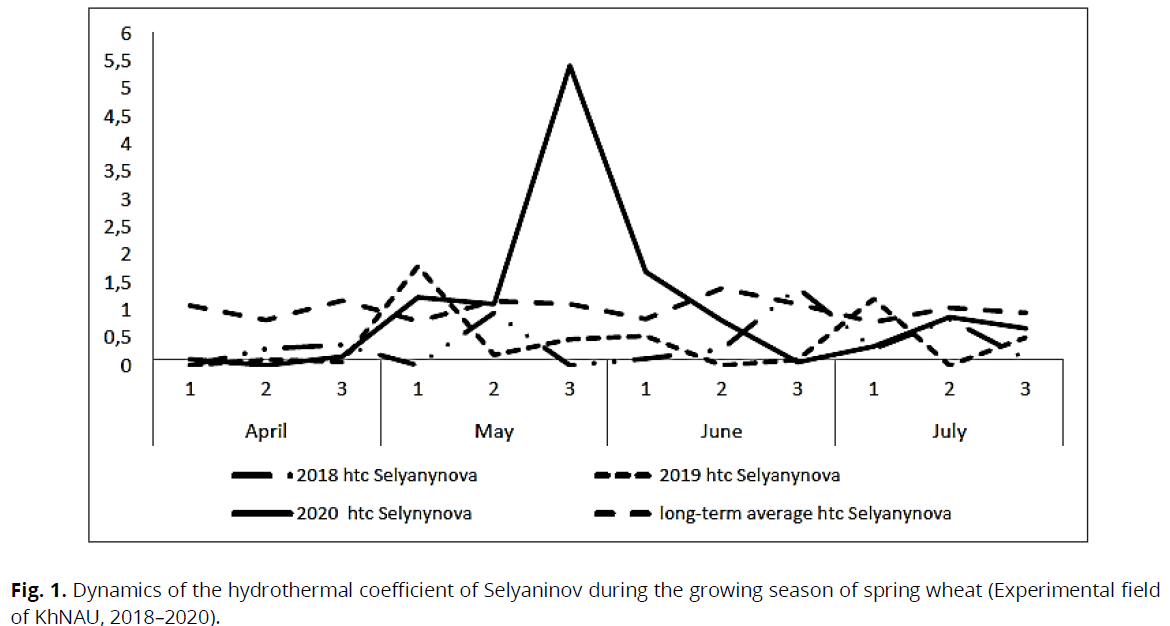
Fig 1: Dynamics of the hydrothermal coefficient of Selyaninov during the growing season of spring wheat (Experimental field of KhNAU, 2018–2020).
Thus, in 2018, the period of the VVSN 09 phase (sowing-seedlings) (09.04–21.04) was characterized by dry conditions (HTC = 0.3; 0.1; 0.0, respectively). In 2018, the VVSN 30 phase (ladder-exit to the tube) took place in three decades of weather conditions and was characterized by arid and dry conditions (HTC = 0.37; 0; 0.95, respectively). Accordingly, in 2019 this period was marked by dry conditions, excess moisture and arid conditions (HTC = 0.07; 1.79; 0.19, respectively), 2020 (HTC = 0.16; 1.23; 1.1, respectively). ). The period of VVSN 21 (beginning of tillering) in 2018 was characterized by dry conditions (HTC = 0). In 2019, the period of VVSN 73 (milk-wax ripeness) was dry (HTC = 0), which did not contribute to the formation and filling of wheat grain. In general, during the study period, the humidity level was insufficient and was characterized in 2018, 2019 (HTC = 0.39; 0.41), and in 2020 was characterized by a sufficient amount of moisture and (HTC = 1.04). Thus, we can conclude that in 2020, BBSN 37 (flag leaf – flowering ears) (HTC was 5.41) contributed to a sufficient filling of grain compared to 2018-2019.
In the period from 2018¬2020, we assessed the morphological variability of the collection of spring wheat, which showed polymorphism on all studied traits. The number of gradations per trait varied from 2 to 8. In populations of collecting samples of spring wheat over the years of the study, the following phenotypes were found: the primary color of spikelets: white, yellow, red, brown, red (Fig. 2);
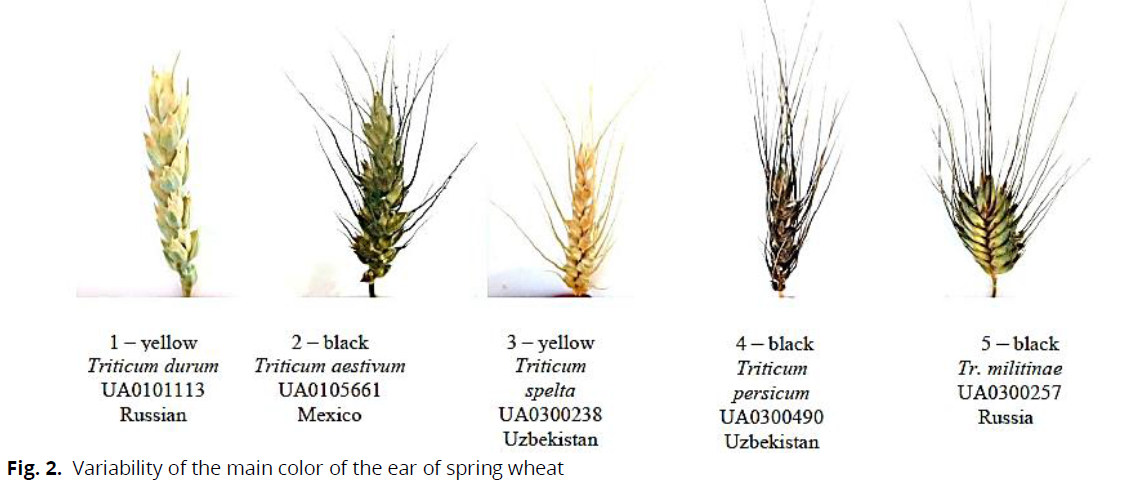
Fig 2: Variability of the main color of the ear of spring wheat
-type of spotting (pigmentation) of the ear: no, a spot in the center, painted more than half of the ear. The revealed morphological signs of pigmentation of a spike of spring wheat are presented in Fig. 3;
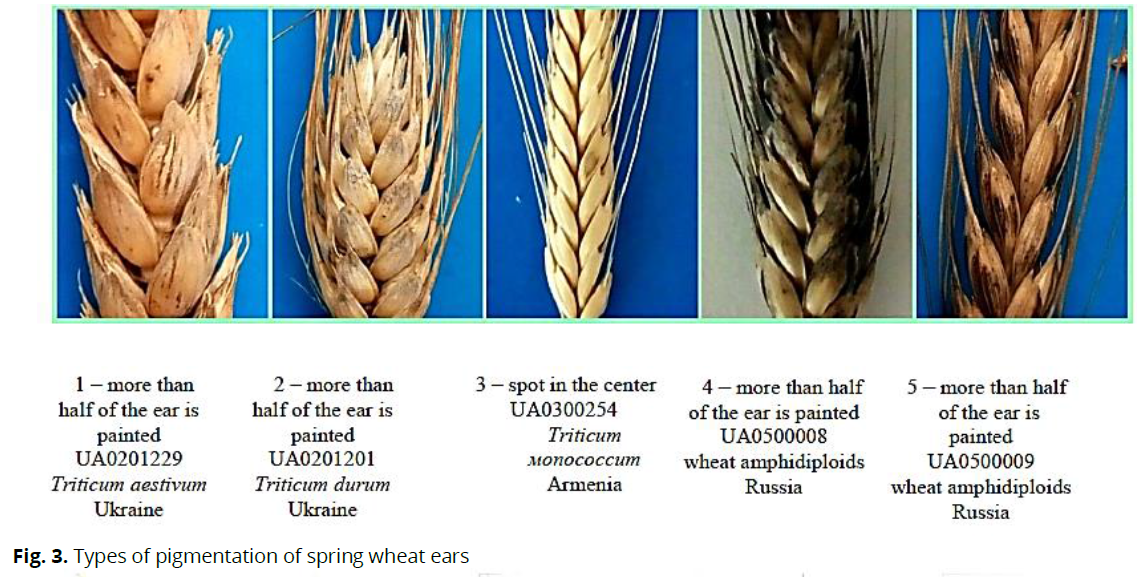
Fig 3: Types of pigmentation of spring wheat ears
-varieties of ear shape: pyramidal, cylindrical, spindle-shaped (middle is wide, narrows up and slightly downwards); club-shaped (extension to the top). Examples of the variety of ear shape are presented in Fig.4;
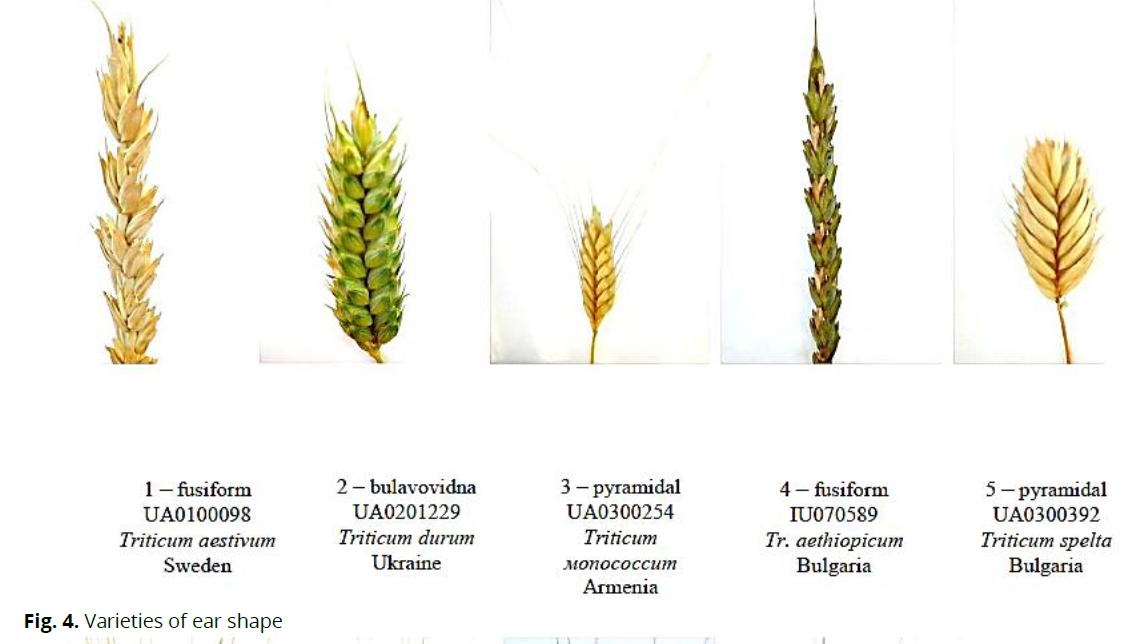
Fig 4: Varieties of ear shape
-varieties of awns: white, red, black (see Fig. 5).
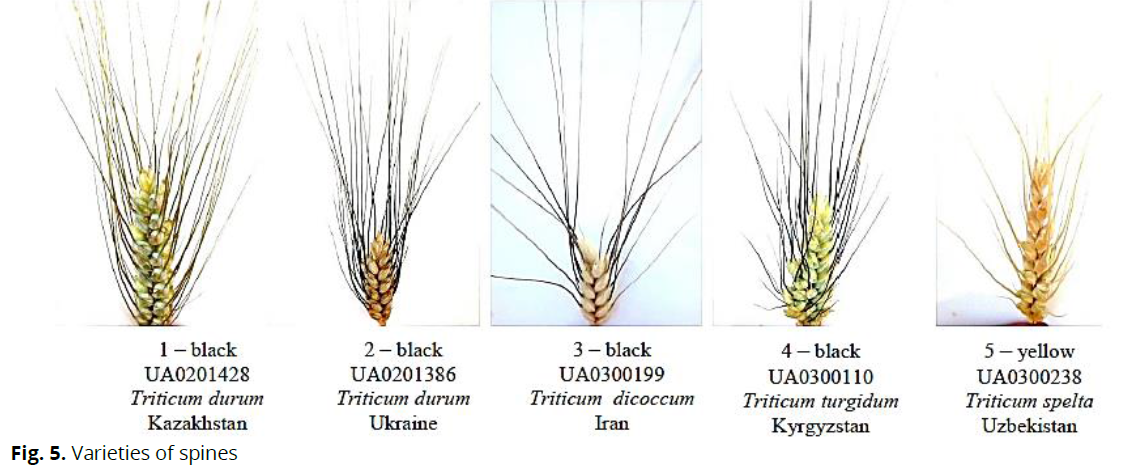
Fig 5: Varieties of spines
Our observations showed that in the conditions of the Eastern Forest-Steppe of Ukraine, the studied samples developed normally, passed all stages of organogenesis, and formed a full-fledged ear. However, during the study period, agrometeorological conditions in different years affected the growth, development, and productivity of culture. The development of spring wheat plants begins with the germination of seeds. The speed of this stage depends on a combination of factors: soil temperature, humidity, and access to oxygen. We observed that the sprouts of spring wheat appear on average on 8-10 days after sowing (Fig. 6). The main factor determining the rate of germination is soil moisture, the primary source of precipitation. The length of the growing season is an essential factor in adapting the culture to environmental conditions. This indicator gives an idea of the prospects for growing different species in certain climatic conditions (Koshkin, 2010). Analysis of the collection of spring wheat by the duration of the growing season and individual phases of development allowed to establish the variation of these traits at the interspecific and intraspecific levels. The results of the analysis are presented in Fig. 7. The duration of the vegetation period (ВВСН 0-99) of spring wheat varies from 120 to 180 days, depending on the type of samples. The collection we studied was represented by genotypes of one group of maturity: medium-ripe. The shortest growing season, which lasted an average of 100 days, was Tr. spelta L. The most extended growing season was characterized by amphidiploid wheat species 105 days on average for all samples of this species.
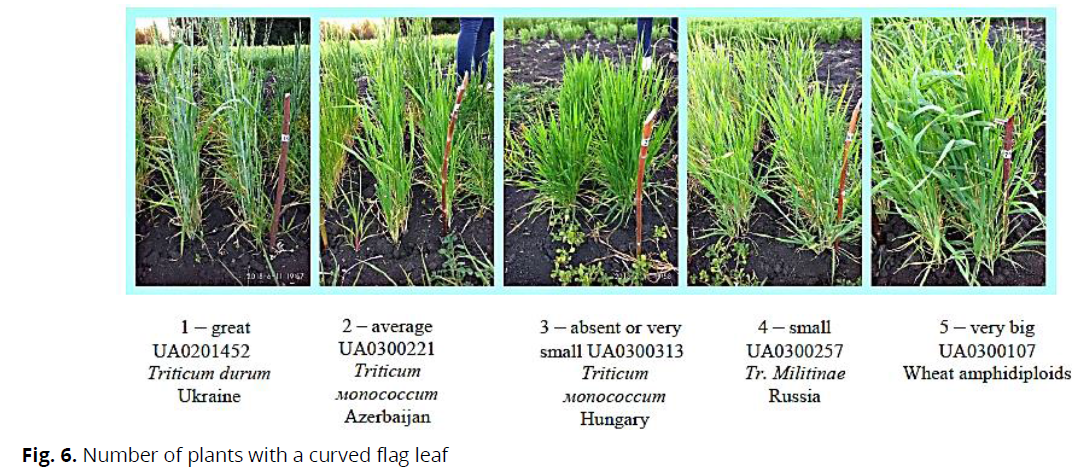
Fig 6: Number of plants with a curved flag leaf
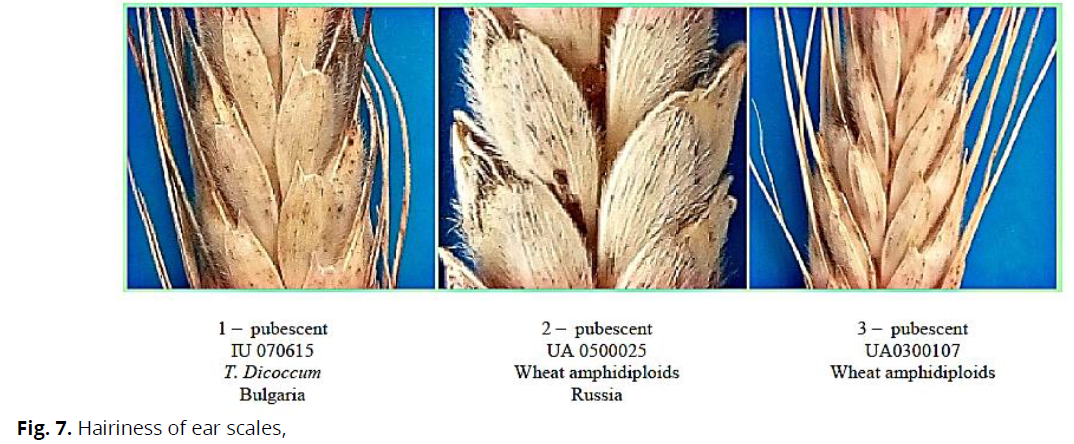
Fig 7: Hairiness of ear scales,
Observations have shown that the phase ВВСН 09–11 (sowing – entire seedlings) was the shortest (average on the species 8.5 days) in the samples of the species – Triticum persicum. The most extended phase of ВВСН 13 (2–3 leaves) was observed in amphidiploid samples of wheat, which lasted 11.6 days. The phase of ВВСН 11–18 (total seedlings – phase of 2th–3rd leaves) was the shortest observed in the samples of the species Triticum dicoccum, which averaged 9.4 days. The period of ВВСН 19-28 (2th–3th leaves – tillering) in samples of the species Triticum spelta was the shortest and amounted to 24.8 days on average for all samples of this species. Amphidiploid samples showed a slightly worse result in this phase and averaged 27.2 per species. Phase ВВСН 29–38 (tillering–exit into the tube) was the shortest was found in samples of the species Triticum persicum on average in the sample was 2.0 days, the most extended phase from tillering to exit into the tube was in samples of the species Triticum aestivum and was 3.7 days on average in appearance. The phenological phase of BBCN 39–49 (exit to the flag leaf tube) was the shortest in Triticum durum and averaged 3.0 days on samples of this species, the longest this phase was found in samples of Triticum dicoccum and is 4.9 days on average by type. ВВСН 49–59 (flag leaf-flowering, earing) was the shortest in Triticum aestivum and was 2.6 days on average for all samples of this species, and the most extended phase of ВВСН 49-59 was found in amphidiploid samples of wheat and was on average for the species 5.1 days. The period of ВВСН 60–78 (flowering, earing – milk–wax ripeness) was the shortest was found in samples of Triticum monococcum and was 5.6 days on average, and the most extended phase was found in Triticum compactum and was nine days on average in samples of this species. Phase ВВСН 78–89 (milk–wax ripeness-maturation) was shortest observed in samples of the species Triticum aestivum and was 25.3 days, on average per species. The longest phase was recorded in Triticum persicum (31.0 days on average). The period of ВВСН 90–99 (ripening–harvesting) was the shortest in Triticum compactum and Triticum persicum (8.5 days), while the longest was in Triticum aestivum and averaged 14.2 days.
| Species | Interphase period | |||||||||||||||||||
|---|---|---|---|---|---|---|---|---|---|---|---|---|---|---|---|---|---|---|---|---|
| Sowing-full seedlings (Ð?Ð?СР09-11) |
Full seedlings – phase of 2thâ??3th leaves (Ð?Ð?СР11-18) |
Phase 2th-3th leaves - tillering (Ð?Ð?СР19-28) |
Tillering-exit into the tube (Ð?Ð?СР29-38) |
Exit to the tube-flag sheet (Ð?Ð?СР39-49) |
Flag leaf-flowering, earing (Ð?Ð?СР49-59) |
Flowering, earing – Milk-wax ripeness (Ð?Ð?СР60-78) |
Milk-wax ripeness-maturation (Ð?Ð?СР78-89) |
Maturation-collection harvest (Ð?Ð?СР90-99) |
Duration of the growing season, days (Ð?Ð?СР0-99) |
|||||||||||
| mean | CV | mean | CV | mean | CV | mean | CV | mean | CV | mean | CV | mean | CV | mean | CV | mean | CV | mean | CV | |
| 1* | 9.0±1.0 | 11.1±1.4 | 11.8±1.1 | 9.7±1.3 | 25.0±1.6 | 7.0±0.9 | 3.7±0.6 | 17.3±2.3 | 3.3±0.6 | 18.3±2.4 | 2.6±0.5 | 20.7±2.8 | 7.6±0.9 | 12.1±1.6 | 25.3±1.7 | 6.6±0.9 | 14.2±1.3 | 8.8±1.1 | 102.3±3.4 | 3.3±0.7 |
| 2 | 8.9±0.9 | 11.2±1.5 | 11.8±1.1 | 9.7±1.3 | 26.0±1.7 | 6.5±0.8 | 2.6±0.5 | 20.7±2.8 | 3.0±0.6 | 19.2±2.6 | 2.8±0.6 | 19.9±2.7 | 6.4±0.8 | 13.2±1.7 | 27.9±1.8 | 6.3±0.8 | 12.5±1.2 | 9.4±1.2 | 101.9±3.4 | 3.3±0.7 |
| 3 | 9.0±1.1 | 12.6±1.7 | 11.9±1.4 | 11.9±1.6 | 26.1±2.1 | 8.0±1.0 | 3.0±0.7 | 23.6±3.2 | 3.7±0.8 | 21.2±2.9 | 3.0±0.7 | 23.6±3.2 | 5.6±1.0 | 17.3±2.3 | 27.3±2.1 | 7.8±1.0 | 11.6±1.4 | 12.0±1.6 | 101.1±4.1 | 4.1±1.1 |
| 4 | 9.4±1.1 | 11.5±1.5 | 11.6±1.3 | 11.1±1.4 | 26.0±1.9 | 7.4±1.0 | 2.1±0.5 | 26.0±3.6 | 4.9±0.8 | 17.1±2.3 | 3.4±0.7 | 20.6±2.8 | 6.4±1.0 | 15.0±2.0 | 27.2±2.0 | 7.2±0.9 | 12.0±1.3 | 10.9±1.4 | 103.0±4.0 | 3.8±0.9 |
| 5 | 9.2±1.1 | 11.6±1.5 | 11.8±1.2 | 10.3±1.3 | 24.8±1.8 | 7.1±0.9 | 3.2±0.6 | 19.7±2.6 | 4.2±0.7 | 17.2±2.3 | 4.0±0.7 | 17.7±2.4 | 6.7±0.9 | 13.7±1.8 | 25.4±1.8 | 7.0±0.9 | 10.4±1.1 | 10.9±1.4 | 100.0±3.5 | 3.6±0.8 |
| 6 | 9.0±1.7 | 19.2±2.6 | 12.0±2.0 | 16.7±2.2 | 25.0±2.9 | 11.5±1.5 | 3.0±1.0 | 33.3±4.8 | 3.5±1.1 | 30.9±4.3 | 4.7±1.3 | 26.5±3.7 | 9.0±1.7 | 19.2±2.6 | 27.7±3.0 | 11.0±1.4 | 8.5±1.7 | 19.8±2.7 | 102.5±5.8 | 5.7±2.0 |
| 7 | 8.7±2.1 | 24.0±3.3 | 12.3±2.5 | 20.1±2.7 | 25.3±3.6 | 14.0±1.8 | 3.0±1.2 | 40.8±6.1 | 3.7±1.3 | 36.9±5.4 | 4.7±1.5 | 32.7±4.7 | 6.7±1.8 | 27.4±3.8 | 29.0±3.8 | 13.1±1.7 | 9.7±2.2 | 22.7±3.1 | 103.0±7.2 | 7.0±2.9 |
| 8 | 8.5±2.9 | 34.3±4.9 | 12.5±3.5 | 28.3±3.9 | 26.0±5.1 | 19.6±2.6 | 2.0±1.4 | 70.7±12.9 | 4.5±2.1 | 47.1±7.3 | 4.5±2.1 | 47.1±7.3 | 6.0±2.4 | 40.8±6.1 | 31.0±5.6 | 18.0±2.4 | 8.5±2.9 | 34.3±4.9 | 103.5±10.2 | 9.8±5.0 |
| 9 | 11.6±0.9 | 7.8±1.0 | 11.7±0.9 | 8.1±1.0 | 27.2±1.4 | 5.3±0.7 | 3.1±15.6 | 15.6±2.0 | 3.4±0.5 | 15.1±2.0 | 5.1±0.6 | 12.2±1.6 | 7.4±0.8 | 10.2±1.3 | 29.9±1.5 | 5.1±0.6 | 5.9±0.7 | 11.4±1.5 | 105.4±2.8 | 2.7±0.5 |
| max | 11.60 | 12.50 | 27.20 | 3.70 | 4.90 | 5.10 | 9.00 | 31.00 | 14.20 | 105.40 | ||||||||||
| min | 8.50 | 11.60 | 24.80 | 2.00 | 3.00 | 2.60 | 5.60 | 25.30 | 5.90 | 100.00 | ||||||||||
| R | 1.36 | 1.08 | 1.10 | 1.85 | 1.63 | 1.96 | 1.61 | 1.23 | 2.41 | 1.05 | ||||||||||
Table 4 The duration of phenological phases and the growing season in the genus Triticum L., 2018-2020 year
Conclusion
The most extended phase ВВСН 09–11 (sowing-full seedlings) was observed in amphidiploid samples (11.6 days), and the shortest phase was recorded in samples of Triticum persicum (8.5 days); the most extended phase ВВСН 11–18 (total seedlings– phase 2x-3 leaves) was observed in samples of Triticum persicumi (12.5 days), and the shortest phase was recorded in samples of Triticum dicoccum (11.6 days). The most extended duration of the vegetation period ВВСН 0-99 was recorded in amphidiploid samples and was 105.5 days, and the shortest growing season was in Triticum spelta (100 days). The duration of the interphase periods mainly depends on heat and moisture. We registered that at the beginning of the growing season of the studied crop, the rate of development phases is significantly influenced by precipitation.
References
Beckmann, J.S. (1983). Restriction fragment length polymorphisms in genetic improvement methodologies, mapping, and costs. Theor. Appl. Genet, 67, 35–43. (in Hebrew).
Biologische Bundesanstalt für land-und Forstwirtschaft Entwicklungsstadien mono und dikotyler Pflanzen. (1997). BBCH–Monograph. – Blackwell Wissenschafts– Verlag Berlin Wien (in German).
Chuprina, Yu.Yu., Klymenko, I.V., Belay, Yu.M., Golovan, L.V., Buzina, I.M., Nazarenko, V.V., Buhaiov, S.M., Mikheev, V.H., Laslo, O.O. (2021). The adaptability of soft spring wheat (Triticum aestivum L.) varieties. Ukrainian Journal of Ecology, 11 (1), 267-272.
Chuprina, Yu.Yu., Klymenko, I.V., Havva, D.V., Golovan, L.V., Buzina, I.M., Titova, A. Ye., Mikheev, V.H., Zabrodina, I.V., Stankevych, S.V. (2020). The level of adaptability of perspective samples of soft and durum spring wheat in Ukrainian forest-steppe. Ukrainian Journal of Ecology, 10(6), 12-22.
Dorofeev, V.F. (1972). The wheat of Transcaucasia. Proceedings on Prikl. Bot., gen. and sat down. Vol 47, 2, 3-202 (in Russian). Dorofeev, V.F. (1990). Udachin. R.A., Semyonova L.V. Wheat of the world. Leningrad. Agroprimizdat (in Russian).
Golovan, L.V., Klymenko, I.V., Stankevych, S.V., Vasylieva, Yu.V., Chupryna, Yu.Yu., Zabrodina, I.V., Zhukova, L.V., Nazarenko, V.V., Belay, Yu.M. (2019). The inheritance of economically valuable features in the intraspecific hybridization of beans (Рhaseolus L). Ukrainian Journal of Ecology, 9(2), 156-169.
Koshkin, E.I. (2010). Physiology of stability of crops. Moscow. Buster (in Russian).
Kostenko, N.P. (2016). Methods of examination of plant varieties of cereals for difference, homogeneity, and stability. Vinnytsia: FOP Korzun D. Yu. (in Ukraine). Kuperman, F.M. (1984). Morphophysiology of plants. Morphological analysis of the stages of organogenesis of various life forms of angiosperm. Moscow. Higher School (in Russian).
Musienko, M.M. (2006). Ecology of plants. Kyiv. Lybid (in Ukrainian). Volkodav, V.V. (2000). Methods of varietal testing of crops. Kyiv (in Ukrainian).
Zubets, M.V. (2010). Scientific bases of agro-industrial production in the steppe zone of Ukraine. Kyiv. Agrarian Science (in Ukrainian).
Author Info
Yu.Yu. Chuprina1, I.V. Klymenko2*, L.V. Golovan1, I.M. Buzina1, Y.M. Belay1, V.H. Mikheev1, V.V. Nazarenko1, S.O. Vynohradenko1 and D.D. Khainus12The ?lant Production Institute named after V. Ya. Yuryev of NAAS, Kharkiv, Ukraine
Citation: Chuprina, Yu.Yu., Klymenko, I.V., Golovan, L.V., Buzina, I.M., Belay, Y.M., Mikheev, V.H., Nazarenko, V.V., Vynohradenko, S.O., Khainus, D.D. (2021). Variability of morphological markers and vegetation period of spring wheat samples of different ecological and geographical origin. Ukrainian Journal of Ecology , 11 (2), 241-248.
Received: 16-Mar-2021 Accepted: 22-Apr-2021 Published: 30-Apr-2021, DOI: 10.15421/2021_106
Copyright: This is an open access article distributed under the terms of the Creative Commons Attribution License, which permits unrestricted use, distribution, and reproduction in any medium, provided the original work is properly cited.
